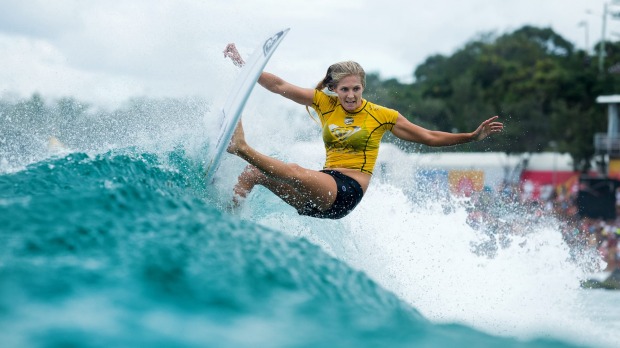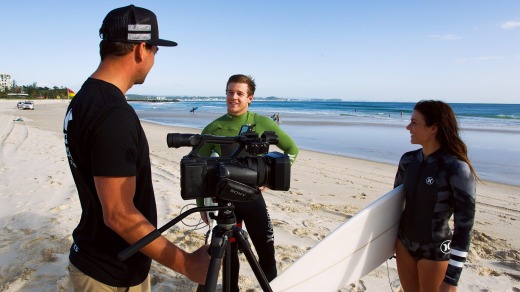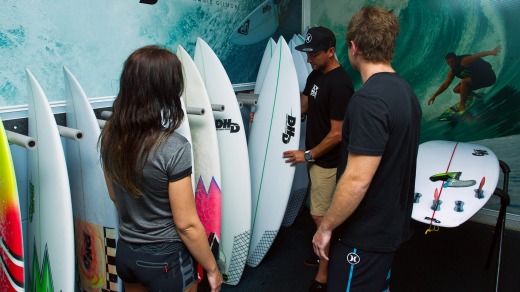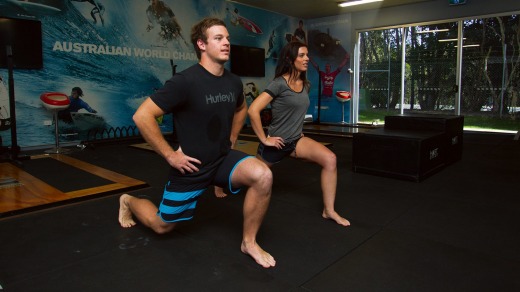
"It can be confronting seeing yourself surf for the first time," says surf guide Linton Fafie of the Hurley Surfing Australia High Performance Centre.
He really wants to know we understand what he's saying. He's making the kind of eye contact that verges on awkward as he speaks – just so he knows he's getting through.
"All those years you've been surfing… and you never really knew how you were doing."

And never have truer words been spoken. It's confronting seeing yourself surfing for the very first time, on a huge plasma TV screen, no less, in a semi-circle of your peers… in a room where only moments before former world surfing champion Joel Parkinson was watching himself surf.
"But," Fafie says. "The only way you'll improve is to see for yourself what you're doing wrong."
And so, with cappuccinos and warm bagels in hand, we prepare to find out if we're actually even doing anything right.

I've assembled with six other surfers outside the centre, just a few hundred metres from the beach, a facility designed to improve the skills of professional surfers.The camps use some of the same coaching techniques professional surfers use to become superstars.
Essentially, a lot of it comes down to video analysis – understanding just what you're doing right and wrong on a wave. Coaches will use video recorders to capture every wave we ride and dissect them later.
There'll also be a surfing coach in the line-up with us to offer advice as we ride the waves, and to help steer us into the best waves. They're there too, I suspect, to make sure we don't hold back on bigger waves – so we go beyond our normal boundaries.

Once those of us who wish to use the surf centre's high-performance surfboards have selected our favourite boards (most elect to use their own ), we're thrown into a van to go and find the best waves in the region.
It turns out they're just around the corner at Cotton Beach. Perfect metre-and-a-half waves break just out front with just a few local surfers riding them. There's surprising venom in these breakers: the first surfer we see as we gather on the beach has snapped his board clean in two. An ominous sign, if ever I've seen one.
We paddle out as a group as Fafie sets up his camera on the beach in front of us. I can't help but back off from every wave that comes through – and there's a reason. Coach Fafie paddles across to me. He knows what I'm thinking, I'm sure not the first: "Just go for it, mate, don't think about the camera."
I take off on the next wave that peaks in front of me, riding it almost all the way to shore. A handful of waves later, it's time to head to the classroom.
Too often, surfing Australia's east coast is an unspoken duel among surfers in an increasingly crowded battlefield. But here it's different, there are no egos on display, we're just seven surfers keen to get more out of our surfing.
That being said, it still takes some resolve to sit among them as Fafie begins his detailed analysis.
For this is what I learn almost immediately as the lights go out and the action starts on the big screen: One, I should look where I'm going when I surf. What the hell is this fixation with my feet anyway? What would Freud say about someone who refuses to even once look where he's going?
Two, I surf with a hunch, and I'm not talking about a slight stoop either, no, I'm talking a Planet of the Apes sort of hunch, back bent over at the waist, knuckles dragging like a living, breathing, surfing orangutan.
And there's more… way, way more. But rather than be dispirited, Fafie points out two or three tips to keep in mind for my next surf.
"This isn't about pointing out all your surfing flaws," Fafie says.
"We'll see five to 10 things wrong with every surfer we see, but we pick out the most important problems and you'd be surprised how quickly you can turn it around and surf so much better."
We spend some time out in the sunshine on long-board skateboards as Fafie teaches me how to overcome my main technique issues.
It's here that surf superstars like Parkinson and fellow WCT contenders Adam Melling and Bede Durbidge come to iron out the kinks in their surfing armour.
Soon after, we gather in the van for another drive down the far north coast. Waves are breaking with almost mechanical perfection along every point we journey past, but the coaches have a secret spot in mind they think we'll have for ourselves.
We paddle out in a pack and sit side-by-side in the line-up. The sun's shining high overhead, the water's crystal-clear and in the distance a lone dolphin surfaces, then arches its back, swimming back down to the depths it came from.
Mt Warning shimmers on the horizon – the tallest peak in these parts. Each time I ride a wave I think harder about what looked worst on film: I ignore my feet and look ahead instead at where I'm going – perhaps for the very first time, and I bend my knees, not my spine, hoping I'll get the monkey off my back.
After my first few waves I even feel myself relax, quite content in these pristine surroundings, focused instead on enjoying the moment, and the company of new, short-term friends.
"We're not teaching you to become pros," Safie says next day, as vision of the last session rolls before us in the board room and I finally retire my dream of joining the World Championship Tour.
"We're just wanting you to get the most out of each surf."
www.visitnsw.com
Most domestic airlines operate from Sydney or Melbourne to the Gold Coast; Casuarina Beach is a 20-minute drive from Gold Coast Airport.
The Hurley Surfing Australia High Performance Centre runs two, three and five-day adult surf camps from $295 (excluding accommodation and meals) or, for an extra $60 a night including accommodation, see www.surfingaustraliahpc.com.
You can stay at the centre, or stay nearby at Peppers Salt Resort & Spa, see www.peppers.com.au/salt